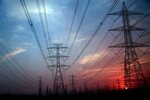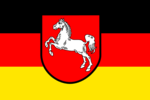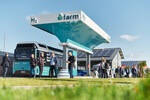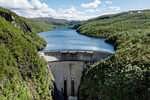News Release from Siemens Gamesa Renewable Energy
Wind Industry Profile of
12/07/2011
Mali - Green electricity from Siemens Energy to supply virgin energy sector
Mali nights are fantastic,” says Piet-Willem Chevalier. “You can see countless stars because there’s no light pollution.” Mali, a country in West Africa, has no national power grid and very few people can afford a diesel generator. That’s why Chevalier, an engineer for dynamic wind turbine analyses at Siemens Energy in Den Haag, wants to supply Mali with green electricity. Since 2008 he has been working in his free time on the “I love wind power” project, which trains Malians to build wind turbines from locally available materials.
Afterwards, trainees will be able to set up their own companies, which will not only make wind power systems, but also offer repair service and battery charging stations. “When a solar cell breaks, you have to buy a new one — but wind power gets local people involved,” says Chevalier, who believes that technological and social progress go together. When asked how he got started, he replies, “I usually work on a computer, but I wanted to build a small wind turbine with my own hands.” On the Internet he found instructions from Scottish developer Hugh Piggott, who has been making wind turbines from simple materials for decades.
“Mali is one of the world’s poorest countries,” explains Brahima Bocar, who comes from the Timbuktu region and works for Siemens in Warsaw. “People often have to walk several kilometers just to get water.” In 2010 Mali ranked 160th among the 169 countries on the United Nations Human Development Index. Desert covers over 60 percent of the country.
Between 1970 and 1990 hundreds of small wind turbines were set up in Mali to pump water, but only a few of them are still in operation, says Bocar. “They were financed by foreign organizations. When the projects were over, no one cared about the pumps any more. The local inhabitants lacked the needed expertise to maintain them. It’s not enough to supply a product, you also have to train and motivate people to keep it running.”
In 2008 Chevalier met Bocar at a Siemens training course in Denmark. Bocar talked about daily life in Mali and Chevalier described the wind turbines he was building. They soon realized that such open-source wind power facilities could transform people’s lives in Mali. Even uneducated people can easily build the turbines, as the blades are made of wood that can be sawed and chiseled into the right shape. The generator consists of coiled copper wire and the rotor spins on a car wheel hub. “You also need a few metal brackets and a pipe for the mast — that’s all,” says Chevalier. It doesn’t cost much to set up the wind turbines, since no expensive tools are required.
Culture Shock. Chevalier subsequently contacted Yvonne Gerner, who lives near the provincial capital of Mopti in Mali. Together with social worker Mamadou “Baba” Traoré, Gerner initiated the Rondom Baba Foundation in 2007. The foundation has bought a hectare of land and is teaching local people agricultural techniques and how to work wood, leather, and metal. It was the ideal partner for Chevalier. “I wanted to find the right people for the project,” he says. “I need people who want to change their lives and set up their own businesses.” None of the ten participants selected for the first workshop had a permanent job. They worked as day laborers; a joiner made furniture and a welder recycled scrap metal and old cars at a junkyard.
When the preparations were completed in December 2009, Chevalier traveled to Mali for the first time. It took him and the foundation two weeks to find the required components, although the materials were all locally available. “I’m impatient, but everything’s different in Africa, even the sense of time,” he says. You have to adjust to the local rhythm “or you won’t even last four days.” Cultural differences turned out to be the biggest problem, not the people’s craftsmanship, as Chevalier had originally expected. “The people in Mali know how to use tools better than I do,” he says.
People Power. Another challenge was Mali’s strict caste system, which regulates which classes of people are allowed to do what. The ten participants nonetheless included two women — a rare situation in Mali’s conservative Muslim society. Every morning Gerner asked the participants to do exercises to strengthen their team spirit. “It was a big step forward when the men and women touched each other’s hands,” she says. Another obstacle was the language, as the Malians speak various local dialects and pronounce French words with a strong accent. Chevalier overcame these difficulties by creating posters to explain how wind turbines are built. “I was initially annoyed that no one asked questions,” he says. “But then I realized they were shy. However, their self-confidence grew after they had built their first wind turbine.”
Chevalier and Gerner managed to buy most of the required materials from local merchants. Only two components had to be imported: permanent magnets from China and polyester to insulate the copper wires, which came from Senegal. In workshops participants learned how to make wind turbines that are between 12 and 20 meters tall with rotor diameters of 1.2 to 4.2 meters.
A turbine with a diameter of three meters has a peak output of 900 watts and an energy yield of 150 kilowatt hours (kWh) per month, explains Chevalier. “The materials and assembly cost around €350, to which you have to add the cost of the mast, batteries, and electronic systems, such as the voltage regulator. Although you can buy these components in Mali, our do-it-yourself technology allows us to make them at 10 to 20 percent of the normal cost.” That reduces the cost of a turbine by several dozen euros.
“If a wind turbine is sold for €650, its electricity costs about 20 euro cents per kWh,” says Chevalier. The electricity produced by a small diesel generator costs 80 euro cents per kWh. “You can therefore achieve the breakeven point after only a year,” he says. Malians who are now getting electricity for the first time in their lives mostly use it for lighting or to recharge their cell phones. Some also buy a refrigerator or a TV.
But Chevalier’s project is now on hold. “We had big storms in August 2010,” reports Gerner. As a result, the mast of one of the four completed turbines snapped. Another three masts have not yet been set up because Chevalier’s private resources have dried up. “So far I’ve paid for everything out of my own pocket and done the work in my free time,” he says. Chevalier must therefore find new sources for funding wind power so that Mali’s people no longer has to live in the dark.
For more information on this article or if you would like to know more about what www.windfair.net can offer, please do not hesitate to contact Trevor Sievert at ts@windfair.net
www.windfair.net is the largest international B2B Internet platform – ultimately designed for connecting wind energy enthusiasts and companies across the globe!
Afterwards, trainees will be able to set up their own companies, which will not only make wind power systems, but also offer repair service and battery charging stations. “When a solar cell breaks, you have to buy a new one — but wind power gets local people involved,” says Chevalier, who believes that technological and social progress go together. When asked how he got started, he replies, “I usually work on a computer, but I wanted to build a small wind turbine with my own hands.” On the Internet he found instructions from Scottish developer Hugh Piggott, who has been making wind turbines from simple materials for decades.
“Mali is one of the world’s poorest countries,” explains Brahima Bocar, who comes from the Timbuktu region and works for Siemens in Warsaw. “People often have to walk several kilometers just to get water.” In 2010 Mali ranked 160th among the 169 countries on the United Nations Human Development Index. Desert covers over 60 percent of the country.
Between 1970 and 1990 hundreds of small wind turbines were set up in Mali to pump water, but only a few of them are still in operation, says Bocar. “They were financed by foreign organizations. When the projects were over, no one cared about the pumps any more. The local inhabitants lacked the needed expertise to maintain them. It’s not enough to supply a product, you also have to train and motivate people to keep it running.”
In 2008 Chevalier met Bocar at a Siemens training course in Denmark. Bocar talked about daily life in Mali and Chevalier described the wind turbines he was building. They soon realized that such open-source wind power facilities could transform people’s lives in Mali. Even uneducated people can easily build the turbines, as the blades are made of wood that can be sawed and chiseled into the right shape. The generator consists of coiled copper wire and the rotor spins on a car wheel hub. “You also need a few metal brackets and a pipe for the mast — that’s all,” says Chevalier. It doesn’t cost much to set up the wind turbines, since no expensive tools are required.
Culture Shock. Chevalier subsequently contacted Yvonne Gerner, who lives near the provincial capital of Mopti in Mali. Together with social worker Mamadou “Baba” Traoré, Gerner initiated the Rondom Baba Foundation in 2007. The foundation has bought a hectare of land and is teaching local people agricultural techniques and how to work wood, leather, and metal. It was the ideal partner for Chevalier. “I wanted to find the right people for the project,” he says. “I need people who want to change their lives and set up their own businesses.” None of the ten participants selected for the first workshop had a permanent job. They worked as day laborers; a joiner made furniture and a welder recycled scrap metal and old cars at a junkyard.
When the preparations were completed in December 2009, Chevalier traveled to Mali for the first time. It took him and the foundation two weeks to find the required components, although the materials were all locally available. “I’m impatient, but everything’s different in Africa, even the sense of time,” he says. You have to adjust to the local rhythm “or you won’t even last four days.” Cultural differences turned out to be the biggest problem, not the people’s craftsmanship, as Chevalier had originally expected. “The people in Mali know how to use tools better than I do,” he says.
People Power. Another challenge was Mali’s strict caste system, which regulates which classes of people are allowed to do what. The ten participants nonetheless included two women — a rare situation in Mali’s conservative Muslim society. Every morning Gerner asked the participants to do exercises to strengthen their team spirit. “It was a big step forward when the men and women touched each other’s hands,” she says. Another obstacle was the language, as the Malians speak various local dialects and pronounce French words with a strong accent. Chevalier overcame these difficulties by creating posters to explain how wind turbines are built. “I was initially annoyed that no one asked questions,” he says. “But then I realized they were shy. However, their self-confidence grew after they had built their first wind turbine.”
Chevalier and Gerner managed to buy most of the required materials from local merchants. Only two components had to be imported: permanent magnets from China and polyester to insulate the copper wires, which came from Senegal. In workshops participants learned how to make wind turbines that are between 12 and 20 meters tall with rotor diameters of 1.2 to 4.2 meters.
A turbine with a diameter of three meters has a peak output of 900 watts and an energy yield of 150 kilowatt hours (kWh) per month, explains Chevalier. “The materials and assembly cost around €350, to which you have to add the cost of the mast, batteries, and electronic systems, such as the voltage regulator. Although you can buy these components in Mali, our do-it-yourself technology allows us to make them at 10 to 20 percent of the normal cost.” That reduces the cost of a turbine by several dozen euros.
“If a wind turbine is sold for €650, its electricity costs about 20 euro cents per kWh,” says Chevalier. The electricity produced by a small diesel generator costs 80 euro cents per kWh. “You can therefore achieve the breakeven point after only a year,” he says. Malians who are now getting electricity for the first time in their lives mostly use it for lighting or to recharge their cell phones. Some also buy a refrigerator or a TV.
But Chevalier’s project is now on hold. “We had big storms in August 2010,” reports Gerner. As a result, the mast of one of the four completed turbines snapped. Another three masts have not yet been set up because Chevalier’s private resources have dried up. “So far I’ve paid for everything out of my own pocket and done the work in my free time,” he says. Chevalier must therefore find new sources for funding wind power so that Mali’s people no longer has to live in the dark.
For more information on this article or if you would like to know more about what www.windfair.net can offer, please do not hesitate to contact Trevor Sievert at ts@windfair.net
www.windfair.net is the largest international B2B Internet platform – ultimately designed for connecting wind energy enthusiasts and companies across the globe!
- Source:
- Siemens Energy - Special thanks to the Author Evelyn Runge
- Author:
- Posted by Trevor Sievert, Online Editorial Journalist
- Email:
- support.energy@siemens.com
- Link:
- www.siemens.com/...
- Keywords:
- siemens, wind, wind energy, wind turbine, rotorblade, awea, ewea, wind power, suppliers, manufacturerstrevor sievert



























